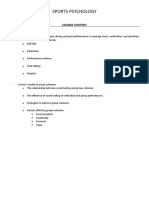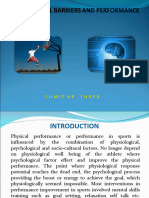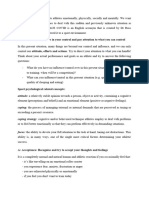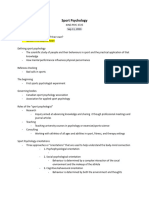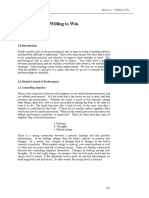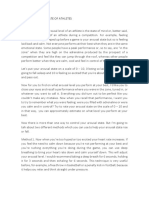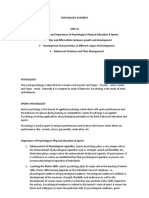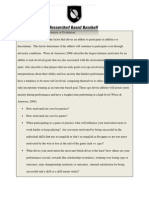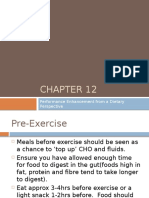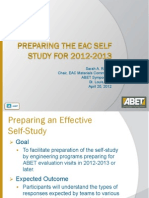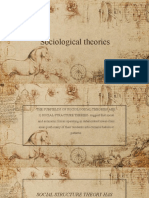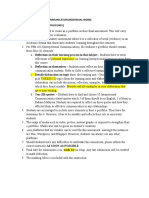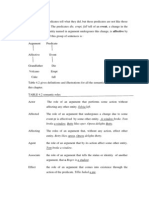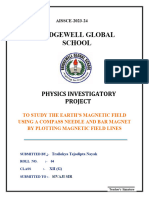Sports Psychology
Sports Psychology
To gain an edge over competitors athletes need to be
not only in an optimum physiological state, but also
an optimum psychological state.
An optimum psychological state can mean being
focused, confident, motivated, in the zone and
optimally aroused.
�Goal Setting
This involves setting targets in different ways to
improve variables such as motivation.
Goals can be geared for both long term and short
term.
Having many short term goals leading into a long
term strategy is often effective.
�Different types of goals can be used for different purposes:
Task/performance goals relate to the athletes own
performance and depend on self improvement(e.g.
Running 10 sec faster in the marathon). Because these goals
do not rely on comparisons with others, they are useful for
improving motivation and confidence. Its all under the
athletes control.
Outcome goals relate to end results and compare athletes
performance to that of others (e.g. Finishing at least 2nd in
the marathon). Although man athletes prefer outcome
goals, they are not usually recommended because they are
not controllable and can be extremely de-motivating and
destroy confidence.
�Process goals refer to a set of actions and strategies
that an athlete must execute during competition to
succeed (e.g. Rehydrating every 10mins during the
marathon). They are useful for organising
performance and can help boost the confidence of an
athlete in the short-term.
�Goal Setting
May enhance performance by focussing attention on
important elements of the skill being performed
Activating and organising an athletes performance
Encouraging perseverance.
��Simulation
Simulation involves mimicking the actual
competition conditions as closely as possible during
training. E.g. Travis Cloke having ipod in his ears at
training with screaming crowd playing while he
shoots for goal.
Simulation tries to be as specific as is practicable to
the psychological pressures that the athlete
experiences during performance, as a result it
lessens the impact of the actual competitive
conditions.
�Mental Imagery
Mental imagery involves replicating as many aspects of
performance as possible in the mind. It is more than
just simple visualisation; it involves recalling all of the
senses that are stimulated during an experience. This
may include:
Visual: what is seen during performance
Auditory: what is heard
Kinaesthetic: how movements feel within the body(e.g.
Which muscles are contracting and which are relaxed)
Tactile: how things that are being touched feel.
�Mental Imagery
For example, a diver may imagine themselves on the
board(visual), how their feet feel touching the edge
of the board(tactile), the eerie silence as they prepare
to dive(auditory) and the movement of their body
during the twists and turns(kinaesthetic).
�Mental Imagery may involve
Achieving a relaxed state prior to creating the
imagery.
Using as many senses as possible to create vivid
images
Controlling the images to bring about positive
outcomes within them.
Using multimedia to enhance the experience; for
example, showing footage and then having the
athlete replicate that footage in their mind.
�Mental Imagery helps performance by:
Allowing the athlete to focus and eliminate
distractions.
Improving neural pathways between the brain and
muscles.
Providing a mental template of rehearsed sequences.
Enabling an athlete to prepare for events they are
likely to encounter.
�Self Talk
Self talk can be negative or positive, and includes
motivational(e.g. you can do it), instructional (e.g.
Bend your knees) or emotional (e.g. Calm down)
talk.
�Sleep
Sleep is essential to creating an optimal
psychological state.
Lack of sleep contributes to:
Reduced concentration, memory, decision making
skills and mental function overall.
Increased stress hormone levels, which heighten the
likelihood of overtraining.
Negative impact on immune system function, which
heightens the likelihood of illness.
�Motivation
�Motivation
Important during training and competition
An athlete with high motivation has a stronger desire
to achieve a goal and is more likely to succeed.
�Motivation
Is evidenced by the following factors:
Choice: voluntary participation shows high
motivation.
Effort: the intensity of effort is a good indicator of an
athletes level of motivation. Motivated athletes train
harder and strive for success during competition.
Persistence: motivation is strongest when it is a
steady and long term trait that is evident despite
adversity.
�Motivation
Extrinsic motivation is derived from external sources
(e.g. Public recognition and money)
Intrinsic motivation is sourced from factors internal
to the athlete (e.g. Enjoyment, learning and
accomplishment). Fostering intrinsic motivation is
important , as it leads to enhanced and sustained
feelings of self-worth.
�Strategies for improving motivation
Feedback: most of it should be motivational
(encouragement) and instructional. Negative
feedback should be sparing.
Positive self talk: this enhance self belief and is a
driving force for effort.
Experiencing success: people that experience success
find more enjoyment in what they do and are more
likely to have greater work output.
Goal setting: encourages perserverence.
�Strategies for improving motivation
Competition: challenges that are internal or external
can draw on individual desires for success and
excellence.
Empowerment: providing players with control over
their own goals can create enthusiasm.
Teamwork: working collaboratively to meet common
goals.
Reinforcement: punishments and rewards can be
used as motivational forces to encourage desirable
behaviour and discourage undesirable behaviour.
�Arousal
Arousal refers to the readiness or alertness an athlete
experiences prior to and during an activity. Low,
moderate or high arousal levels are appropriate to
different circumstances.
The inverted U hypothesis states that their is an
optimal level of arousal for various events and
athletes, which elicits the best performance. In other
words, the athlete is motivated, able to concentrate
and in the zone.
��Arousal
Low levels of arousal are characterised by low
motivation, lethargy, distraction and apathy. Low
arousal can suit some events though including
archery and shooting.
High arousal levels are typically associated with
nervousness, anxiety, elevated heart rate, reduced
coordination and decreased concentration. Again can
suit some athletes.
�Arousal Regulation-Reduction Strategies
Progressive muscle relaxation.
Breathing control.
Biofeedback-use of electronic devices (e.g. Heart rate
monitor) to enhance self awareness.
Meditation
Stress Inoculation Training- like simulation exposing
yourself to stressful situations and develop strategies to
cope
Coping strategies-e.g. Mental imagery, pre game routines,
social support, soothing music.
Routines.
�Arousal Regulation-Elevation Strategies
Rapid breathing
Positive self talk
Energetic music
Motivational imagery-visualise successful
performance
Active warm ups
�Concentration
The ability to maintain focus on relevant stimuli is
referred to as concentration.
To concentrate is to pay attention to what is
important in the external and internal environments.
�Concentration involves
Focusing on relevant cues: blocking out noise
(distractions); that is, having selective attention.
Maintaining attention focus: not allowing
concentration to lapse over time.
Shifting focus when appropriate: being able to
change which cues are being attended to and focused
upon.
�Strategies for improving Concentration:
Simulation-modifying training to be competition specific so
player can practice blocking irrelevant cues.
Mental imagery-creates stronger neural pathways and
reinforces important aspects of skill.
Self talk-E.g. Michael Clarke watch the ball
Planning: organises and gives focus
Routines: help focus
Overlearning skills- autonomous stage, focus on tactics
Non-judgemental thinking-forget past poor performances.
Regulating arousal
Process goals-help to direct and organise performance.


